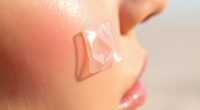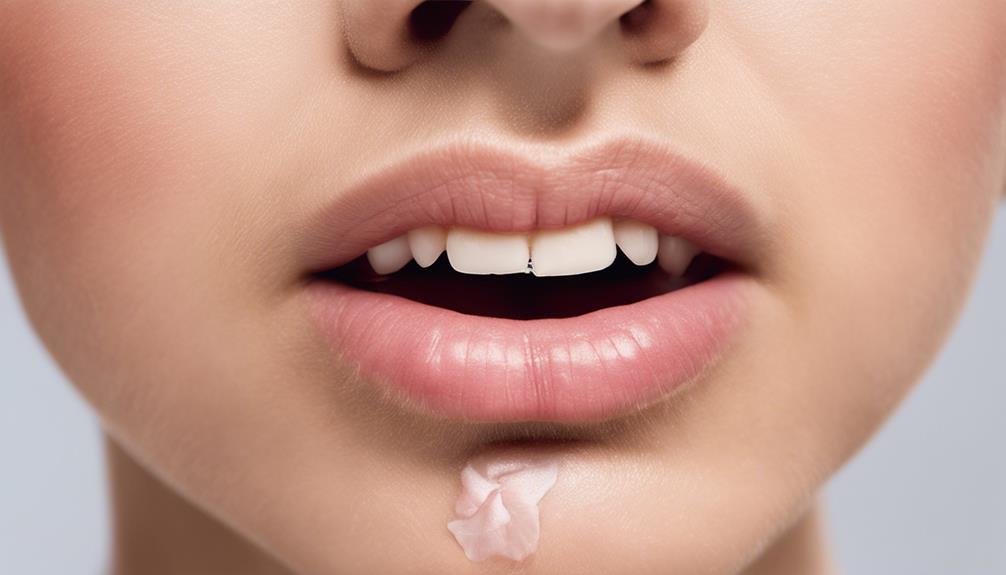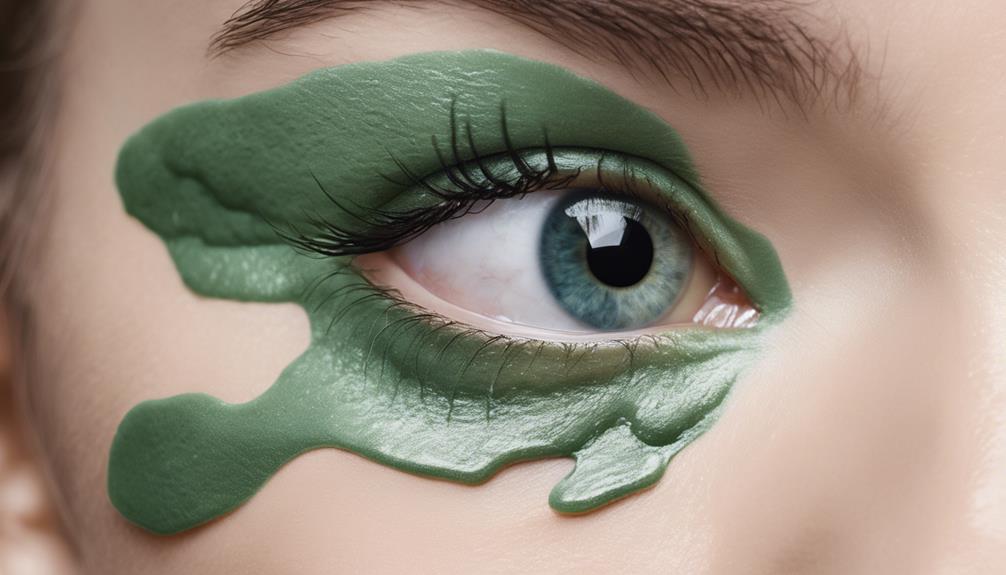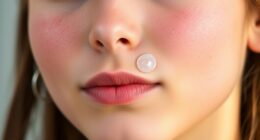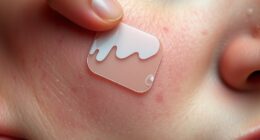Pimple patches can start showing visible improvements in as little as six hours for smaller pimples. For best results, leave the patch on overnight or for up to 24 hours. These patches absorb excess oil and soothe inflammation immediately when applied. Just remember to clean and dry your skin before using them. If you’re curious about the different types of patches or how to use them for various pimples, there’s more to discover.
Key Takeaways
- Visible improvements can occur in as little as six hours for smaller pimples when using a pimple patch.
- Leaving the patch on overnight enhances its effectiveness and speeds up healing.
- Many patches can be worn for up to 24 hours for maximum results and absorption.
- A white patch indicates it has fully absorbed pus, signaling successful treatment.
- For best results, ensure skin is clean and dry before applying the patch.
Duration of Effectiveness

How quickly can you expect results from a pimple patch? You might see visible improvements in as little as six hours, especially for smaller pimples like whiteheads.
Leaving the patch on overnight enhances its effectiveness, aligning with your skin’s natural repair process. Many patches can be worn for up to 24 hours, maximizing results. Pimple patches begin working immediately by absorbing oil and soothing inflammation.
For optimal results, leave the patch on overnight to sync with your skin’s natural healing process.
When the patch becomes white, it’s a sign that it’s fully saturated with pus, indicating success. To boost effectiveness, guarantee your skin is clean and dry before applying.
Hydrocolloid patches absorb pus and oil without drying your skin, and those with active ingredients like salicylic acid can speed up healing.
Consistency in use is key for long-term benefits.
Types of Pimples Treated

When dealing with acne, understanding the types of pimples you’re treating can greatly enhance your approach. Hydrocolloid patches work well for surface-level pimples like whiteheads, blackheads, papules, and pustules. They help maintain moisture, reduce inflammation, and absorb excess oil and pus. This is because hydrocolloid patches form moisture around the problem area, which draws out fluid from the pimples.
For inflammatory acne, medicated patches with salicylic acid can target bacteria, while their protective barrier prevents infection. Cystic and nodular breakouts might require microneedling patches that deliver ingredients deeper into the skin, although they can be uncomfortable.
While pimple patches don’t directly treat post-inflammatory hyperpigmentation (PIH), they help prevent picking that could worsen it. Overall, choosing the right patch for each pimple type can enhance your healing process.
How Pimple Patches Work

Pimple patches work by creating a protective barrier over your blemish, ensuring a healing environment while preventing bacteria from entering.
Pimple patches form a protective barrier to promote healing and block bacteria from worsening blemishes.
Made from hydrocolloid, these patches absorb excess fluids and impurities like oil and dirt, which helps reduce inflammation and flatten whiteheads. The adhesive properties keep the patch securely in place, while hydrocolloid promotes ideal healing conditions maintains moisture, promoting ideal healing conditions. Many users find hydrocolloid technology particularly effective for faster recovery from acne.
By sealing off the pimple, the patches protect against irritation from picking or scratching, further minimizing the risk of scarring.
You’ll want to clean and dry your skin before application, and for best results, leave the patch on for 4 to 8 hours. Some patches can even be worn overnight for stubborn spots.
Benefits of Using Pimple Patches

While dealing with breakouts can be frustrating, using pimple patches offers several notable benefits that can enhance your skincare routine.
First, they reduce inflammation by absorbing pus and fluid, diminishing redness quickly. Pimple patches also act as a barrier, preventing you from picking at your pimples, which can lead to scarring and further irritation. Additionally, hydrocolloid film protects your skin from dirt and bacteria, reducing the risk of infection. Moreover, these patches often contain salicylic acid that helps to further target and treat acne, making them a powerful ally in your skincare arsenal. Plus, most patches are discreet, so you can wear them throughout the day without drawing attention.
Effectiveness in Various Scenarios

Pimple patches can considerably reduce inflammation and absorb excess fluid within 6 to 8 hours, making them ideal for quick fixes. For best results, wear them overnight, allowing continuous absorption of pus and oil. Hydrocolloid patches are particularly effective for whiteheads and surface-level pimples, while deeper cystic acne may need microneedling patches. Medicated options can target early-stage pimples, while herbal patches offer a gentler alternative. Additionally, hydrocolloid is a polymer that forms a gel with water, which aids in creating a moist environment for skin healing. Keep in mind that results can vary based on your skin type and consistency of use. Applying patches to clean, dry skin enhances adhesion and efficacy, so make sure you follow these guidelines for best outcomes.
Best Practices for Use

When using pimple patches, following best practices can greatly enhance their effectiveness. Start by cleansing your skin with a gentle cleanser to remove dirt, oil, and makeup. Confirm your skin is completely dry before applying the patch, which should fit the pimple perfectly. Aim to wear the patch for at least six hours—up to 12 hours is ideal, and you can extend it to 24 hours for stubborn blemishes. Additionally, pimple patches are recommended for overnight use for the best results. Replace the patch when it turns white, indicating it’s absorbed its maximum potential. Avoid using patches on open pimples, and monitor your skin for irritation. For the best results, wear patches overnight and combine them with your regular skincare routine for added benefits.
Frequently Asked Questions
Can I Use Pimple Patches on Sensitive Skin?
Yes, you can use pimple patches on sensitive skin, but you need to choose carefully.
Opt for non-medicated hydrocolloid patches, as they’re gentler and less likely to cause irritation. Always perform a patch test to check for any reactions before applying it to larger areas.
Products designed specifically for sensitive skin, like Neutrogena’s Sensitive Skin Blemish Patches, can also be effective.
Just remember to maintain your skincare routine for best results.
Are Pimple Patches Safe for All Skin Types?
Did you know that nearly 50% of people experience skin irritation from acne treatments?
When it comes to pimple patches, they’re generally safe for most skin types, but you should be cautious if you have sensitive skin.
Allergic reactions can happen, so it’s wise to patch test on a hidden area first.
Always clean and dry your skin before application to minimize irritation and maximize effectiveness.
Keep an eye out for any adverse reactions!
How Often Can I Use Pimple Patches?
You can use pimple patches daily, but it really depends on your skin type and the severity of your breakouts.
If you’ve got sensitive skin, you might want to limit your usage to avoid irritation.
Remember, patches aren’t a substitute for your regular skincare routine; they complement it.
After removing a patch, applying moisturizer can help prevent dryness and keep your skin hydrated.
Just be mindful of not overusing them to maintain healthy skin.
Can I Apply Makeup Over a Pimple Patch?
You can definitely apply makeup over a pimple patch!
Just make sure to use lighter products, like liquid or powder foundation, to keep it looking natural. Avoid heavy or oil-based makeup, as it can enhance the patch’s visibility.
Apply your makeup gently, blending it well to achieve a seamless finish. Remember to keep the edges of the patch clear, and consider using a setting spray for lasting wear.
Enjoy your flawless look!
Do Pimple Patches Expire or Have a Shelf Life?
You might think all pimple patches are created equal, but they don’t all expire the same way.
Hydrocolloid patches can last for up to five years if stored properly, while those with active ingredients like salicylic acid have a shorter shelf life.
Using expired patches can lead to irritation or reduced effectiveness, so always check the packaging and store them in a cool, dry place to get the best results.
Conclusion
In just 6-8 hours, pimple patches can greatly reduce blemishes, making them a quick fix for your skincare woes. With over 50% of teens experiencing acne, you’re not alone in this struggle. Using these patches not only helps clear your skin but also boosts your confidence. Remember to apply them correctly for the best results, and embrace the journey to clearer skin. You deserve to feel good about yourself every day!

